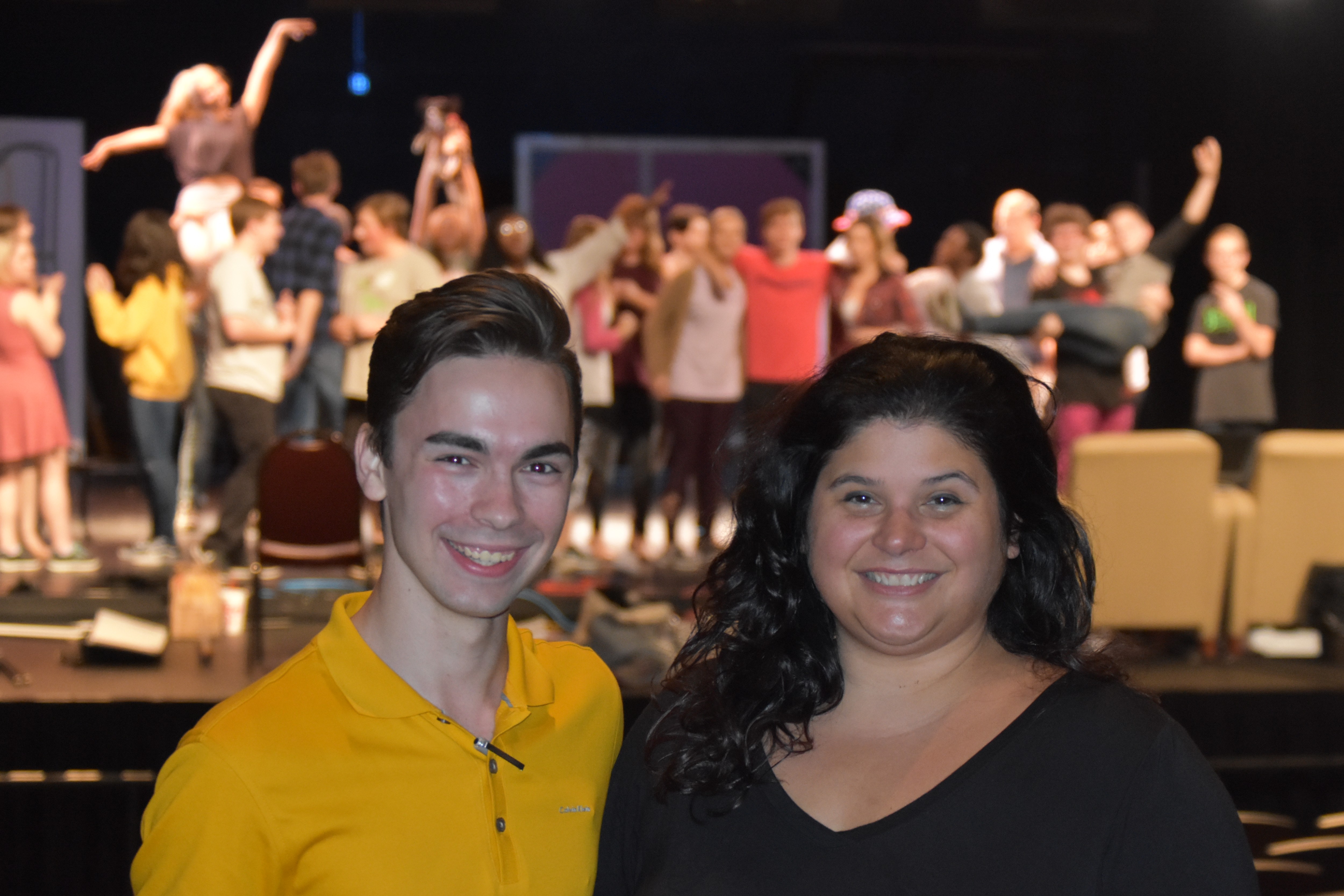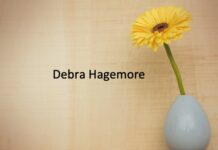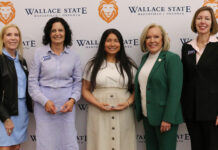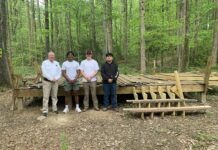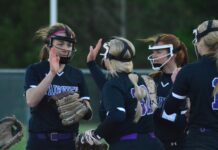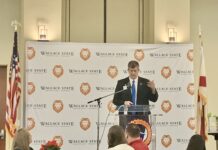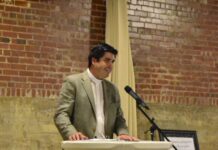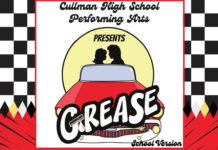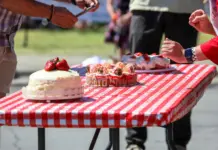Technical Director Noah Carpenter and Show Director Lauren Salerno are planning what may be north Alabama’s first sensory-friendly theater performance in this year’s production of “Mary Poppins” at Wallace State. (W.C. Mann for The Cullman Tribune)
HANCEVILLE – On Oct. 25-28, the Wallace State Community College (WSCC) Theatre program will take audiences back to 1910-era London’s Cherry Tree Lane for its fall production of the classic “Mary Poppins.” And the creative team behind the show has promised that we will see the world’s most magical nanny fly.
The Tribune dropped by the Betty Leeth Haynes Theatre at WSCC on Thursday to watch a little rehearsing and talk with Show Director Lauren Salerno and Technical Director Noah Carpenter, both about the show itself, and about their announcement that the production would include a Sunday matinee that might be north Alabama’s first ever sensory-friendly theater performance.
“It’s a great big show,” said Salerno. “There’s a lot of moving parts, but we have a newly-renovated theater that gives us a lot more capability than we had before, so I wanted to do something this year to showcase the space or the new things that we could do. So, for the first time, we are flying someone on stage. I’ve not done that before. She’s going to fly! We’ve got a company coming in to rig the system.
“Also, I chose this show, really, because I felt like I had the right students for the parts. I’ve kind of been waiting to do this show, and then I sort of got just the right talent this year to do it.
“You know, it’s colorful and fun. It’s a lot like the movie, but there’s also some new songs and new pieces to the story that we get in the musical.”
The “wow” factor: flying and other technical challenges
“I think that the music and choreography’s really fun,” said Salerno. “There are big dance numbers. ‘Step in Time’ is a really cool number. There’s a lot going on: you know, they dance on the rooftops. It’s visually really cool, and it’s big.
“I’d say, you know, she’s going to fly and Bert flies as well. So, they’re in the air, and they’re even dancing a little bit in the air sometimes.”
Carpenter added, “In my experience, any time you put somebody in the air, everybody just kind of sits back in their seats, and that’s kind of always a wow factor.
“Our flying company, they’ll come in and do all of our training and stuff, and they’ll kind of leave us to it, so that’s always a fun aspect of flying. But, really, a lot of the other technical aspects are just Mary’s magic: like anytime she makes something appear from somewhere that you wouldn’t expect it or brings control and order back to complete chaos, like, all of those are very technical aspects that have to be done from behind the scenes.”
Salerno chimed in, “Noah, what do you mean? It’s magic!”
“This is going to be a beautiful show to be able to come in and see,” said Carpenter. “I have already started dreaming about our lighting design for the show, and we are hoping to be able to make a lot of live transitions happen with the design.”
Sensory-friendly performance
The Sunday matinee performance of Mary Poppins will feature a sensory-friendly approach to appeal to audience members on the autism spectrum, and others.
Carpenter explained, “A sensory-friendly show is mainly targeted to audiences who have sensory disorders, or that in one way or another fall onto the spectrum. The show's purpose is to take the theater, which so much of the time is an uninviting place to these audiences, and make some small but impactful changes that will help make the show easier for these patrons while not removing any of the art or magic of the show for them.
“As the technical director, a lot of the pieces in a sensory-friendly show do land in my plate. We do adjustments to lighting to eliminate any strobe lights or bright flashes, we leave the house lights up a little bit to prevent the stage from being too bright and overwhelming for patrons, and then on the sound side everything is turned down just a little and we soften any harsh sound effects like crashes or explosions. In addition to these things, a sensory-friendly show has a very open-door policy to allow patrons to come and go as they need to if they are overstimulated, and a lot of the house rules are relaxed: patrons are able to interact in the ways that best help them enjoy the show; they can sing along or clap, or anything they need to help them take it all in. The program is also a little different for a show like this, because we use it as kind of a roadmap for patrons and give warnings about parts of the show that might be overstimulating for certain patrons, and also include character comparisons for our characters compared to who they were in the movie, to cut down on confusion.”
The master controls for sound and stage lighting will be turned down just a little, and the house lights will stay slightly brighter than usual to allow audience members to see things happen around them better. A special printed program will also alert parents and caretakers to points in the show where startling or noisy events will take place, to give them the opportunity to prepare.
Salerno talked about why she chose to add such an option to the performance schedule:
“We’ve never done a sensory-friendly production. It’s definitely on my radar, because a lot of theater companies are starting to do that sort of thing. I had a mom email me to ask if we were going to do one, because she would like to bring her child, but she had recently been to a performance that wasn’t sensory-friendly, and she didn’t feel that it was a positive experience for her child. And I thought, ‘Why aren’t we doing that? We should be doing that.’
“So I talked to my department chair, and we decided that Sunday afternoon would be a good time to offer that, because it’s a daytime show. And I can’t imagine that we’ll ever do a production again where we don’t have a sensory-friendly opportunity, because you want everybody to be able to experience theater. You want everybody to be able to experience the arts. And if people are uncomfortable, or if they feel they’re being judged in any way, that’s not going to happen, and then you feel like you can’t offer them that.
“I’m going to bring my kid to that one, because there’s a lot more freedom; like if people need to move, if people need to make noise, it’s okay. We’ve already talked to the cast about it, about just always continuing on with the show, and knowing that there may be other elements that day, and that the best thing to do is just to say ‘Yes’ and move on through it.
“We’re also going to do photographs of the cast members out of costume, so people know that they’re real people, you know. And I think we’ll have to say that Mary Poppins flies, so that they’ll be prepared for her to take flight.
“The good news is about this production is that, while there’s a lot of orchestration and singing, there’s not a tremendous amount of giant sound effects or, there’s a couple of lighting things, but again the auditorium lights will be kept on a bit low, so there are less triggers.”
Carpenter added, “This is revolutionary. I think, as much as I’ve looked into it–because it’s a project of mine right now, like this will probably be the first sensory-friendly (show). I think Red Mountain’s done a couple of sensory-friendly shows, but north Alabama: this is the first sensory-friendly theater show that I can find. And really, what it does is like it’s going to open a door for people who like the magic in theater (which) is so much more intensified and stuff for these patrons.
“And like, for me, it’s super personal, because I’m extremely dyslexic. So, to be able to open up theater and know what it’s done in my life; and, if I had not had a theater that opened up to me, I wouldn’t be here talking to you. So, just for us to be some of the frontrunners in Alabama, doing that, making that movement for these patrons, is something super special that we’re able to do in the show, also.”
Salerno concluded, “I think that there’s no way you can’t have fun if you come see the show.”
Cast
- Mary Poppins: Samantha Drake
- Bert: Rayce Cleghorn
- George Banks: Justin Weygand
- Winifred Banks: Cheyenne Smith
- Jane Banks: TBA
- Michael Banks: TBA
- Katie Nanna / Ensemble: Abigail Pass
- Policeman / Ensemble: Carson Partain
- Miss Lark / Ensemble: Caroline Grimes
- Admiral Boom / Ensemble: Riley Adams
- Mrs. Brill / Ensemble: Chloe Nutt
- Robertson Ay / Ensemble: Blake Tetro
- Miss Andrew / Ensemble: Isabella Allred
- Park Keeper / Ensemble: Cole Lawrence
- Neleus / Ensemble: Conner Gully
- Queen Victoria / Ensemble: Anna Eads
- Bank Chairman / Ensemble: Eli Parker
- Von Hussler / Ensemble: Dallas Fields
- Northbrook / Ensemble: Samuel Hewitt
- Bird Woman / Ensemble: Jes Fortenberry
- Mrs. Correy / Ensemble: Lacey Johnson
- Fannie / Ensemble: McCoy Cleghorn
- Annie / Ensemble: Essence James
- Valentine / Ensemble: Sabrina Myers
- Teddy Bear / Ensemble: Emily Douglas
- Mr. Punch / Ensemble: Alexa Dempsey
- Doll / Ensemble: Ashlynn Teeling
- Toy / Ensemble: Brooke Norris
- Ensemble: Jorrelle Webster
Creative team
- Director: Lauren Salerno
- Technical Director: Noah Carpenter
- Musical Director: David Giambrone
- Assistant Choreographer: Duke Cleghorn
Technical/stage crew
- Assistant Stage Managers/ Props: Breanna Spangler, Abby Moody
- Props Crew Head: Hannah Glassco
- Props Crew: Ashlynn Teeling, Sabrina Myers, Essence James, Blake Tetro
- Make-Up: Emily Douglas, McCoy Cleghorn, Lacey Johnson, Jes Fortenberry, Caroline Grimes,
- Set Crew Head: Chloe Nutt
- Set: Isaiah Washington, Meredith Jordan, Victoria Sports, Carson Partain, Conner Gully, Riley Adams, Eli Parker, Justin Weygand, Rayce Cleghorn,
- Light Crew Head: Samuel Hewitt
- Light Crew: Dallas Fields, Cole Lawrence
- Hair/ Wigs: Weslie Beasley, Abigail Pass
- Costumes: Samantha Drake, Cheyenne Smith, Isabela Allred
Mary Poppins
- Oct. 25-28, in the Betty Leeth Haynes Theatre on the Wallace State campus
- Admission is $5 for children, $10 for adults
- Thursday, Oct. 25 at 7 p.m.
- Friday, Oct. 26 at 7 p.m.
- Saturday, Oct.27 at 7 p.m.
- Sunday, Oct. 28 at 2 p.m.
Copyright 2018 Humble Roots, LLC. All Rights Reserved.

